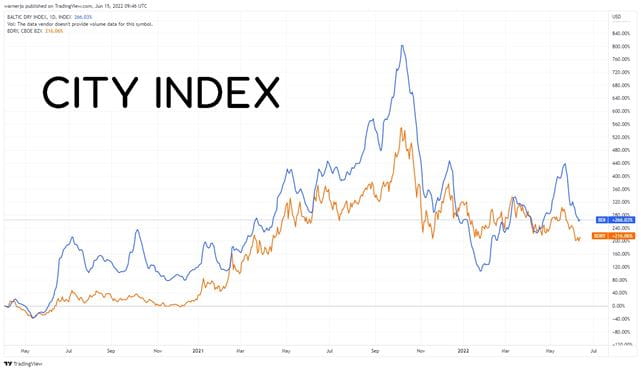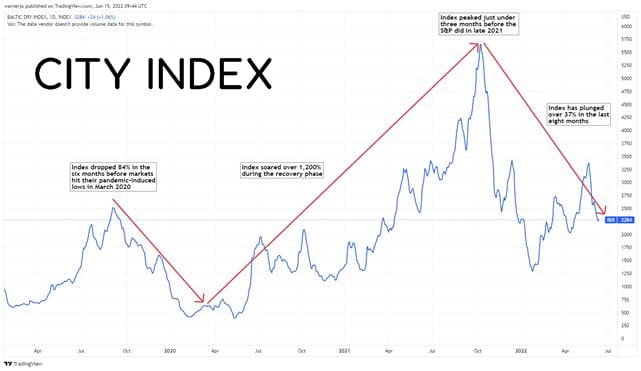
Baltic Dry Index and shipping stocks suffer
The Baltic Dry Index hit a two-month low this week, having plunged by one-third over the past four weeks alone. It has now fallen some 37% since peaking at its highest level since the 2008/2009 financial crisis last October. Meanwhile, the Breakwave Dry Bulk Shipping ETF – which tracks the price of one-to-six-month freight futures – has followed the Baltic Dry Index lower.

This has filtered through to shipping stocks, which have come under severe pressure this month. We have recently seen the likes of Maersk, Golden Ocean, Navios Maritime Partners and Star Bulk Carriers hit their lowest level in months, while others including ZIM Integrated Shipping, Danaos and Textainer Group have recently touched their lowest levels since 2021.
Shipping stocks hit by fears of stagflation and demand destruction
Shipping rates soared during the first 10 months of 2021 as a strong recovery from the pandemic caused demand to significantly outstrip supply, but these have unravelled over the past six months as new problems plague the global economic outlook.
We saw inflation start to rise in February and this was then exacerbated in March by both the revival of Covid-19 lockdowns in China and the eruption of conflict in Ukraine, both of which added to pre-existing supply chain problem. Russia’s invasion has also severely disrupted the trade of coal and grain, two of the most-traded products within the dry bulk industry.
Rampant inflation has led markets to believe central banks will have to be more aggressive when it comes to raising interest rates. That in turn has hurt growth expectations and talks of a possible recession have grown in recent weeks, casting a cloud of doubt over the world’s recovery prospects. This could curtail demand for products, reduce investment and prompt major infrastructure projects to be delayed, crimping demand for dry bulk commodities and pushing shipping rates lower.
Forde Morkedal, an analyst at Clarkson Platou Securities, recently warned that ‘demand destruction is a major source of concern’ for the shipping industry.
Looking forward, China offers the best hope of reviving demand if it can refrain from plunging the country back into lockdown. While it has eased restrictions in recent weeks, it is still operating a zero-tolerance approach toward the virus and the fact testing remains rife and that some areas are still in lockdown suggests Covid-19 will remain a problem going forward. But a full reopening could be hugely beneficial considering China is among the biggest consumers of dry bulk commodities like coal and iron ore.
The other headwinds look less likely to resolve themselves anytime soon considering there are no signs that the conflict in Ukraine will end, and we are yet to hit peak inflation.
Why does the Baltic Dry Index matter?
The Baltic Dry Index tracks the shipping rates for dry bulk commodities used by over 20 global routes on a daily basis, providing a holistic view of the industry.
Around two-thirds of all dry bulk trade is made up of just three commodities - iron ore, coal and grain. The remaining third is made up by the likes of fertiliser, steel, cement and salt.
The Baltic Dry Index can prove volatile, and this is because any minor changes in supply or demand can have a dramatic effect on shipping rates. Cargo ships vary in size but even the smallest that just operate along coastlines will carry at least 500 tonnes of goods, while the largest dry bulk carrier in the world can carry up to a staggering 400,000 tonnes. Regardless of size, cargo fleets tend to remain fairly stable and new supply cannot be introduced overnight. This means any spike in demand for dry bulk commodities (or a swift reduction in the number of vessels available) can significantly push up prices as companies race to secure some space amid limited freight capacity, and quickly unwind when demand falls or more vessels enter the market.
Because dry bulk shipping involves transporting vital raw materials, this can be among the first to experience any shifts in supply and demand before becoming evident through other economic data such as manufacturing, production, or sales rates. Therefore, the Baltic Dry Index is known for being a leading indicator of global economic activity by signalling changes in the market for vital raw materials needed to produce everything from food to steel, and power major industries from construction to agriculture.
With this in mind, Hellenic Shipping News reported last month that orders and construction of new dry bulk ships has slowed significantly in 2022 as the uncertain economic outlook prompts caution, which should keep supply tight and keep the focus on demand.
Baltic Dry Index: A solid indicator of future economic growth?
The Baltic Dry Index has been a useful indicator in the past and has proven to be accurate in gauging where global markets are headed.
The index plunged over 90% within the first few months of the 2008-2009 financial crisis erupting and then acted as a solid bellwether as the global economy recovered. Similarly, the index has been a reliable indicator since the Covid-19 crisis started. The Baltic Dry Index plunged some 84% in the six months before global stock markets bottomed-out because of the pandemic in March 2020. It then soared over 1,200% during the recovery phase and peaked in October 2021, almost three months before the S&P 500 peaked at the end of the year.

This supports the view that the Baltic Dry Index is a useful tool when speculating where markets are headed next. The steep drop in recent weeks is significant, although it is important to remember that rates remain above the 11-month low hit in January and are still largely above what we saw before the pandemic started.
How to trade the Baltic Dry Index
The Baltic Dry Index can be used as a wide-reaching indicator used in a broader trading strategy involving a wide range of instruments. You cannot trade the index directly, but there are several ways to gain exposure.
The easiest way is to trade shipping stocks because they are highly sensitive to movements in rates. It is important to note that shipping stocks covers a wide range of companies, not just those involved in dry bulk commodities, and that there are very different types of players using a wide range of business models. For example, the Baltic Dry Index tracks rates for a variety of vessel sizes, and the rates for each can vary wildly on any given day. Some companies make money by operating regular routes on a fixed schedule, while others generate cash by leasing out their ships to other companies. There are other players to consider too, such as those that build ships. The point this highlights is that the array of shipping stocks available to trade have different drivers to consider.
Other options available are to trade the companies that produce the dry bulk commodities, such as miners like Rio Tinto, Anglo American or BHP that churn out considerable amounts of iron ore and coal.
You can trade a number of stocks with City Index in just four easy steps:
- Open a City Index account, or log-in if you’re already a customer.
- Search for the stock or instrument you want to trade in our award-winning platform
- Choose your position and size, and your stop and limit levels
- Place the trade
Or you can try out your trading strategy risk-free by signing up for our Demo Trading Account.





